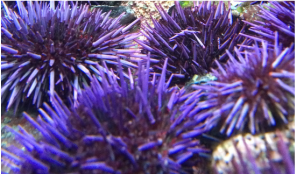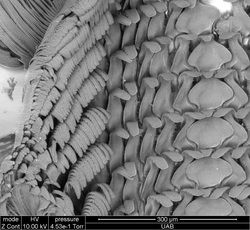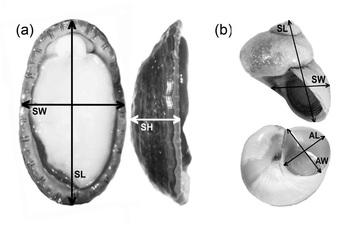I approach mentoring partnerships with the underlying belief that a mentor, above all else, is a facilitator, providing inclusive opportunities for students to explore something new by either communicating about or providing students with openings to independently investigate research questions that interest them. I encourage personally driven learning in a supportive and inclusive environment through collaboration, experiential learning, and self-assessment. I often rely on tiered mentorship in laboratory settings and strive to work with people from a wide variety of backgrounds to enrich learning opportunities for myself and my students. To achieve this, good communication is absolutely essential. Using effective, clear, and thoughtful communication is a critical component of ensuring that the goals of both mentor and mentee are achieving personal and professional goals. Ensuring that clear communication happens takes continued attentiveness to update and respond to the needs of the mentor and mentee.
One method that has become a core part of establishing my mentoring relationships is use of contracts (web-workshop “What matters in mentoring” (four 2-hr sessions) offered through the Center for the Improvement of Mentoring Experiences in Research (CIMER) at Univ. Wisconsin-Madison). When I start a new mentoring relationship, we discuss and fill out the contract together and then revisit it yearly to update the contract stipulations as needed. I have used the contracts to communicate and establish baseline expectations for myself and for the student. Some of the aspects stipulated include the type of feedback students prefer and frequency of meetings. In this way, I set the stage for the development of a collaborative relationship that values individual and shared research goals and vision of success while establishing a framework for reaffirming or revising our progress and set the timing and frequency of feedback. I believe this personalizes and customizes feedback that will best benefit this type of working and mentoring relationship.
One method that has become a core part of establishing my mentoring relationships is use of contracts (web-workshop “What matters in mentoring” (four 2-hr sessions) offered through the Center for the Improvement of Mentoring Experiences in Research (CIMER) at Univ. Wisconsin-Madison). When I start a new mentoring relationship, we discuss and fill out the contract together and then revisit it yearly to update the contract stipulations as needed. I have used the contracts to communicate and establish baseline expectations for myself and for the student. Some of the aspects stipulated include the type of feedback students prefer and frequency of meetings. In this way, I set the stage for the development of a collaborative relationship that values individual and shared research goals and vision of success while establishing a framework for reaffirming or revising our progress and set the timing and frequency of feedback. I believe this personalizes and customizes feedback that will best benefit this type of working and mentoring relationship.
| schram_mentoringphilosophy.pdf | |
| File Size: | 53 kb |
| File Type: | |
Current and past student collaborators
|
Graduate students
Undergraduate students
- Maddi McArthur: serving as M.S. committee member for work to be completed at the University of Alaska Fairbanks - Influence of an environmental cascade on high-latitude intertidal communities
- Nicole Nakata: serving as Ph.D committee member for work to be completed at the University of Oregon - Evolution of Development in Brittle Stars (Echinodermata: Ophiuroidea)
- Hannah Oswalt: serving as Ph.D committee member for work to be completed at the University of Alabama at Birmingham - The effects of ocean acidification and ocean warming on Antarctic macroalgae and macroalgal-associated amphipods
- Nathan Spindel: collaborated on fatty acid component of Ph.D work through Florida State University- Trophic dynamics and environmental change affect the metabolic ecology of size-structured populations
- Ross Whippo: collaborated on fatty acid component of Ph.D work at the University of Oregon - Fatty acid dynamics of macroalgae across a latitudinal gradient of the western Antarctic Peninsula
- Carly Salant: collaborated on fatty acid component of M.S. work at the University of Oregon - Trophic biomarkers indicate coastal surf zone hydrodynamics affect resource assimilation by Mytilus californianus mussels
- Mike Thomas: collaborated on fatty acid component of M.S. work at the University of Oregon - Juvenile Dungeness crabs (Metacarcinus magister) selectively integrate and modify the fatty acids of their experimental diets
- Dr. Michael Meyer: collaborated on fatty acid component of Ph.D work through Washington State University - fatty acid trophic modeling in lake habitats (Lake Baikal, Russia; Flathead Lake, USA)
- Dr. Sara Hamilton: collaborated on fatty acid component of Ph.D work at Oregon State University - Fatty acid dynamics of purple urchins along the Oregon coast
- Dr. Reyn Yoshioka: collaborated on fatty acid component of Ph.D work at University of Oregon - Eelgrass pathogen Labyrinthula zosterae
synthesizes essential fatty acids - Dr. Wendel Raymond: collaborated on fatty acid component of Ph.D work at the University of Alaska Fairbanks - Sea otter effects on trophic structure of seagrass communities in southeast Alaska
Undergraduate students
- Kenedy Williams: UAS undergraduate student, Fall 2021 & Spring 2022 - sea star physiological responses to ocean acidification
- Hannah Forshee: UAS undergraduate student, Fall 2021 & Spring 2022 - sea star behavioral responses to ocean acidification
- Hannah Hayes: OIMB REU student, summer 2019; research assistant summer 2020- juvenile Dungeness crab behavioral responses to ocean acidification
- Steven Manos: OIMB REU student, summer 2019 - juvenile Dungeness crab behavioral responses to ocean acidification
- Natalie Thompson: OIMB REU student, summer 2018 - intertidal isopod coloration, juvenile Dungeness crab response to ocean acidification
- Leela Dixit: OIMB REU student, Summer 2017 - intertidal isopod coloration and feeding ecology
- Zade CLark-Henry: OIMB REU student, Summer 2017 - Dungeness crab feeding ecology
- Nic Aguiluz: OIMB undergraduate student, Summer & Fall 2016 - intertidal invertebrate feeding ecology
- Connor Stein: UAB Undergraduate student, Spring & Fall 2015 - microscopy analysis Antarctic mollusc shells and gastropod radulae
- Casey Phillips: UAB undergraduate student, Spring 2013 - quantified Antarctic gastropod mollusc shell morphology
Previous mentee responsibilities and feedback:
Nic Aguiluz - Summer, Fall 2016
|
Project – Sea urchin subsidies: Intertidal copepod growth potential
My primary responsibilities: - Assisted in design and development of independent research project - Provided feedback on written project proposals - Helped student with project troubleshooting Nic's description of his experience: My research project focuses on the implications of the purple sea urchin Strongylocentrotus purpuratus as a facilitator of population growth in tide pool suspension feeders. I collect the feces of these urchins to feed to populations of Tigriopus californicus in comparison to algae based diets in order to assess growth of populations based on diet. Julie has been a massive help in all areas of my project. From design to troubleshooting and even animal care, Julie has proved herself as an invaluable resource to my first independent laboratory experiment. She is always approachable and willing to work with me and other lab members to ensure the success of our projects. I look forward to continuing my work with her and plan to remain in contact as colleagues throughout my career. |
Connor Stein - Spring, Summer, Fall 2015
Casey Philips - Spring 2013
|
Project – Antarctic snail and limpet shell analysis of morphometrics as part of climate change experimental growth analysis – a laboratory project
My primary responsibilities: - Introduced basic image analysis techniques and principles - Provided relevant background information - Advised in productive scientific writing practices Casey's description of his experience: "In Julie Schram's lab I worked on examining differences in gastropod shell development in response to varying pCO2 treatments that simulated different levels of ocean acidification. Julie acted as my mentor for the lab and helped me to understand how to use the image analysis program we utilized and what exactly we were trying to accomplish there. She was always willing and able to answer any questions I might have about the lab work or any other topics. I enjoyed coming in every day because I knew I had pleasant and helpful lab mates to help me deal with any issues that might arise." |



